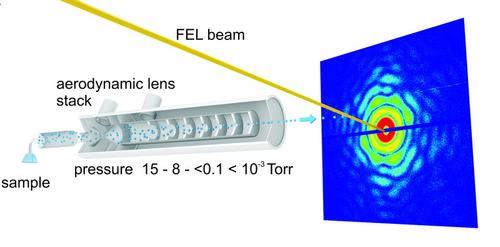Coherent Diffractive Imaging
This relatively new technique (especially injected samples, e.g. electro-sprays, at free electron lasers) produces extremely high data rates that are limited only by the frame rate of the detector systems used. Experience gained from the first CDI experiments shows that only 10-20% of all frames contain useful information. The aim then is to establish a data pipeline for simple, programmable evaluation of individual frames, which is capable of triggering the rejection of useless frames at full data collection speed. For applications like coherent diffraction imaging or X-ray photon correlation spectroscopy, especially if time resolution is required, a high signal-to-noise ratio is essential. Currently, the data analysis is limited due to the fact that the images recorded via a CCD-detector need to be sampled over a few frames. This leads to an otherwise preventable increase in the background level. Fast data analysis on a frame-to-frame basis would significantly improve data quality and also prevent smearing due to the current integration over several frames.
